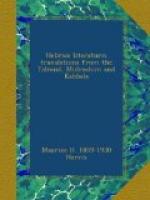“And Saul said unto the Kenites, Go, depart, etc.; for ye showed kindness to all the children of Israel” (1 Sam. xv. 6). And did they show kindness to all the children of Israel? No; but what is written is to teach that he who receives a disciple of the wise as a guest into his house, and gives him to eat and to drink, is as if he had shown kindness to all the children of Israel.
Midrash Sh’muel, chap. 18.
Rabbi Levi says, “When Solomon introduced the ark into the Temple, all the woodwork thereof freshened with sap and began to yield fruit, as it is said (Ps. xcii. 13), ’Those that be planted in the house of the Lord shall flourish in the courts of our God.’ And thus it continued to bear fruit, which abundantly supplied the juveniles of the priestly caste till the time of Manasseh; but he, by introducing an image into the Temple, caused the Shechinah to depart and the fruit to wither; as it is said (Nah. i. 4), ‘And the flower of Lebanon languisheth.’”
Midrash Tillin Terumah.
The land of Israel is situated in the centre of the world, and Jerusalem in the centre of the land of Israel, and the Temple in the centre of Jerusalem, and the Holy of holies in the centre of the Temple, and the foundation-stone on which the world was grounded, is situated in front of the ark.
Midrash Tillin Terumah, Kedoshim.
In Ezek. v. 5 we read, “I have set Jerusalem in the midst of the nations and countries that are round about her.” On the literal interpretation of these words it was asserted that Jerusalem was the very centre of the world, or, as Jerome quaintly called it, “the navel of the earth.” In the Talmud we find a beautiful metaphor in illustration of this view. It is in the last six lines of the ninth chapter of Derech Eretz Zuta, which read thus: “Issi ben Yochanan, in the name of Shemuel Hakaton, says, ’The world is like the eyeball of man; the white is the ocean which surrounds the world, the black is the world itself, the pupil is Jerusalem, and the image in the pupil is the Temple. May it be built in our own days, and in the days of all Israel! Amen!’” The memory of this conceit is kept alive to this day among the Greek Christians, who still show the sacred stone in the Church of the Holy Sepulchre at Jerusalem. This notion is not confined to Jewry. Classic readers will at once call to mind the appellation Omphalos or navel applied to the temple at Delphi (Pindar, Pyth., iv. 131, vi. 3; Eurip. Ion., 461; AEsch. Choeph., 1034; Eum. 40, 167; Strabo,




